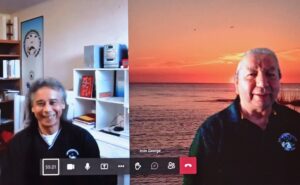Waabnoong Bemjiwang uses technology for precise infrastructure strategy

By Kelly Anne Smith
PICKEREL— Before digitization, Infrastructure Specialist Randy Roy couldn’t say how many fire hydrants were in the First Nations within the Waabnoong Bemjiwang Association of First Nations tribal council territory. Now he knows exactly how many there are and any possible information about them.
Roy has been part of a team of experts building a ‘smart nation’ asset management system.
Dokis First Nation, Henvey Inlet First Nation, Magnetawan First Nation, Nipissing First Nation, Wahnapitae First Nation, and Wasauksing First Nation are member communities of Waabnoong Bemjiwang Association of First Nations (WBAFN) that will see the implementation of the new asset management system.
WBAFN’s research and support have been able to help establish a platform with tools and business procedures for maintaining a system of information with respect to managing capital and maintenance activities. Work orders, accounting information, and level of service standards are used to forecast current and future infrastructure needs.
WBAFN Executive Director Irvin George gives credit for the asset management system development to Project Manager Scott McKever and GIS Coordinator Hannah Burke, representatives from member First Nations, and Randy Roy.
“Randy has been very instrumental providing the direction for the development of the asset inventory repository system that we’ve developed over the past few years.”
Roy says managing paper-based information is very hard, adding that a large part of the project was moving information from a paper base to a digital base.
“Moving away from file cabinets and rolled up drawings and plans and into a digital environment that can be accessed with security,” he explains. “We are asked all the time by the federal government, or whoever, ‘What are your needs? What are your needs for housing? Can you fill out this survey? What are your needs for water?’”
“Data is power as opposed to estimating. Having that solid information to draw from I think is power. Now it’s a reform of information management for First Nations infrastructure. First Nations are taking ownership of that information. ”
Roy says the focus is on infrastructure but there is potential for other uses.
“The platform of our database is in a GIS Esri environment. That tool is shared by lands people. We’ve been working together and we share these costs to access that technology. That’s been a plus for lands and infrastructure.”
He explains its use if one was interested in a culvert for example.
“Click on the culvert and it tells me the culvert size, it was installed on this date— here’s the specifics about it. I can attach pictures about it. I can attach inspection reports to that point on the map. All of our members can interact with the information.”
Roy says the system is also used by the water treatment operators to manage their work.
“They can see what work they have upcoming. They have the records of the things they did.”
“The work order system is in addition to remote monitoring capability that we’ve installed in our member community water plants that they can remotely monitor what goes on with the processes inside the plants,” adds George. “So, if they have a breakdown, they can respond.”
WBAFN also worked with KPMG on developing an asset management plan (AMP) for the First Nations says George.
“AMP’s were developed for all six First Nations – using data from the system,” he explains. “In the absence of service [delivery] standards, KPMG have used the provincial standards that they use when they develop asset management plans for municipalities. But on the federal side, the federal ledger, there are no standards for service delivery… The provincial standard approach was selected to form a starting point – a first draft of what an Annual AMP could look like. This is still in the works.”
Roy says everything is in place to control their own information and speak to it.
“Currently, a formal asset management plan is not required. However, First Nations regularly provide information for their annual audit statements on infrastructure to give the value of the tangible capital assets – our infrastructure. And there are needs statements as well. Needs and conditions are factored into the values,” Roy says. “Up to now, the accountants like KPMG have been leading that front in terms of the audit information. To get in there within that financial realm with the top leadership to say, ‘Here’s what we need’; KPMG is giving us that backing.”
WBAFN’s Executive Director says the asset management system would be beneficial for all First Nations.
“When we first started this project, it was to develop some tools for our member communities to better manage their assets in a different way than they normally do,” says George. “It was a lot of work but we couldn’t have accomplished what we have without the support of our funders from Fednor and NOHFC (Northern Ontario Heritage Fund Corporation) and ISC (Indigenous Services Canada) and the tribal council itself, including the Council of Chiefs and Board of Directors. The communities have also supported the system… We are looking at options on how our system could help other First Nations or Tribal Council’s to achieve similar reforms as we have in a Smart Nation approach.”


